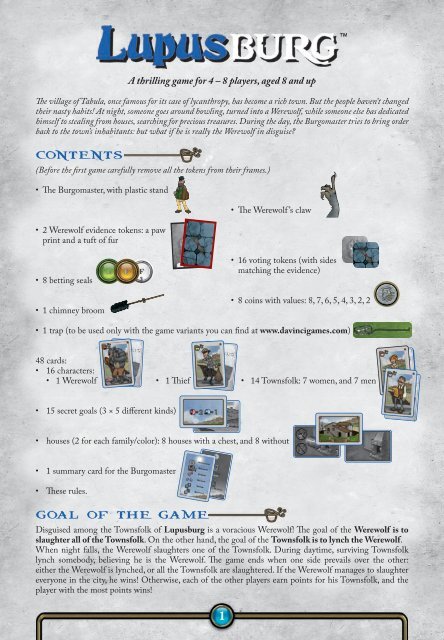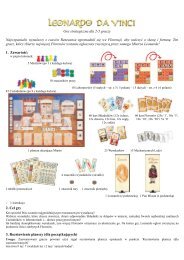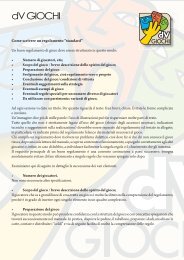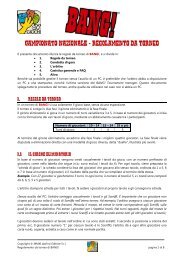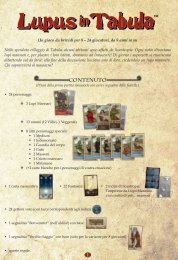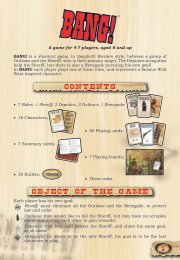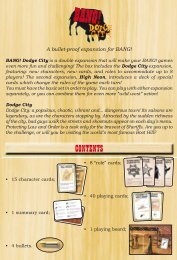Lupusburg - rules - daVinci Games
Lupusburg - rules - daVinci Games
Lupusburg - rules - daVinci Games
You also want an ePaper? Increase the reach of your titles
YUMPU automatically turns print PDFs into web optimized ePapers that Google loves.
A thrilling game for 4 – 8 players, aged 8 and up<br />
The village of Tabula, once famous for its case of lycanthropy, has become a rich town. But the people haven’t changed<br />
their nasty habits! At night, someone goes around howling, turned into a Werewolf, while someone else has dedicated<br />
himself to stealing from houses, searching for precious treasures. During the day, the Burgomaster tries to bring order<br />
back to the town’s inhabitants: but what if he is really the Werewolf in disguise<br />
CONTENTS<br />
(Before the first game carefully remove all the tokens from their frames.)<br />
• The Burgomaster, with plastic stand<br />
• 2 Werewolf evidence tokens: a paw<br />
print and a tuft of fur<br />
• The Werewolf ’s claw<br />
• 8 betting seals<br />
• 1 chimney broom<br />
• 16 voting tokens (with sides<br />
matching the evidence)<br />
• 8 coins with values: 8, 7, 6, 5, 4, 3, 2, 2<br />
• 1 trap (to be used only with the game variants you can find at www.davincigames.com)<br />
48 cards:<br />
• 16 characters:<br />
• 1 Werewolf • 1 Thief • 14 Townsfolk: 7 women, and 7 men<br />
• 15 secret goals (3 × 5 different kinds)<br />
• houses (2 for each family/color): 8 houses with a chest, and 8 without<br />
• 1 summary card for the Burgomaster<br />
• These <strong>rules</strong>.<br />
GOAL OF THE GAME<br />
Disguised among the Townsfolk of <strong>Lupusburg</strong> is a voracious Werewolf! The goal of the Werewolf is to<br />
slaughter all of the Townsfolk. On the other hand, the goal of the Townsfolk is to lynch the Werewolf.<br />
When night falls, the Werewolf slaughters one of the Townsfolk. During daytime, surviving Townsfolk<br />
lynch somebody, believing he is the Werewolf. The game ends when one side prevails over the other:<br />
either the Werewolf is lynched, or all the Townsfolk are slaughtered. If the Werewolf manages to slaughter<br />
everyone in the city, he wins! Otherwise, each of the other players earn points for his Townsfolk, and the<br />
player with the most points wins!<br />
1
PRE PAR ATION<br />
The owner of the game takes the Burgomaster, or gives it to a player at random.<br />
Sort the cards by type: houses, characters, and secret goals.<br />
Each player chooses a color, and takes the two matching houses and the betting seal; he also takes two<br />
voting tokens.<br />
Each player lays his two houses face up in front of him, so that they form a circle as shown in the picture.<br />
Only the owner knows which of his two houses hides his precious treasure chest!<br />
Shuffle the secret goals. Deal one secret goal to each player. Each player looks at his goal and keeps it face<br />
down in front of him. Keep the deck of remaining goals face down, handy.<br />
Build a deck of characters depending on the number of players:<br />
4 players: 1 Werewolf, 1 Thief, 3 men, 3 women<br />
5 players: 1 Werewolf, 1 Thief, 4 men, 4 women<br />
6 players: 1 Werewolf, 1 Thief, 5 men, 5 women<br />
7 players: 1 Werewolf, 1 Thief, 6 men, 6 women<br />
8 players: 1 Werewolf, 1 Thief, 7 men, 7 women<br />
Shuffle the cards. Deal two characters face down to each player.<br />
If a player gets both the Werewolf and the Thief, reshuffle the cards and deal them out again.<br />
Each player secretly looks at his characters, and keeps them secret until the game ends!<br />
Important note: if a player has the Werewolf or the Thief, both of his characters act as the<br />
Werewolf or the Thief! In other words, the player will act as a Werewolf or as a Thief, until both<br />
of his characters are out of the game! (For simplicity’s sake, during the <strong>rules</strong>, we will refer to the<br />
player with the Werewolf or with the Thief just with ‘the Werewolf ’ or ‘the Thief ’ respectively.)<br />
Each player puts a character under one of his houses, and the other one under his<br />
other house. Once placed, houses and characters cannot be moved.<br />
Important: the Werewolf and the Thief may not be placed under the house<br />
with the chest!<br />
Place the Werewolf claw in the middle of the table so that it does not point to any<br />
particular house.<br />
Take the coins with the following values, based on the number of players:<br />
4 players: 4, 3, 2, 2<br />
5 players: 5, 4, 3, 2, 2<br />
6 players: 6, 5, 4, 3, 2, 2<br />
7 players: 7, 6, 5, 4, 3, 2, 2<br />
8 players: 8, 7, 6, 5, 4, 3, 2, 2<br />
Arrange the coins into a stack by value, from the lowest (bottom) to the highest (top).<br />
Keep the stack handy.<br />
The Burgomaster keeps the two<br />
Werewolf evidence tokens and the<br />
summary card handy.<br />
If you are playing with 6 to 8 players,<br />
the Burgomaster also takes the chimney<br />
broom. Put any unused materials back<br />
in the box.<br />
Note: each player may look at his<br />
characters, houses and secret goal at<br />
any time during the game. However,<br />
he may never show any of these to the<br />
other players!<br />
Make a circle with the houses, and place<br />
the claw in the middle; no other card may<br />
go there. Place the houses so that each<br />
player may comfortably reach them all<br />
with one hand.<br />
2
HOW TO GAIN VICTORY POINTS: CHARACTERS, SECRET GOALS, CHESTS AND BETS<br />
In <strong>Lupusburg</strong> (unlike in Lupus in Tabula), there is always only one winner! Either the Werewolf<br />
wins, or if he gets lynched, the player with the most points wins! Points are earned for your living<br />
characters, by completing a secret goal, saving your own chest, and winning your bet.<br />
LIVING CHARACTERS<br />
You gain 2 victory points for each of your character still alive when the game ends.<br />
SECRET GOAL<br />
You gain the victory points stated on your secret goal if your characters match the stated conditions<br />
when the game ends. During the game, you may discard your goal and draw a new one, if you still<br />
have any living characters,.<br />
THE CHEST<br />
You have two houses. One of them conceals a chest that is worth 1 victory point. In order to save<br />
your chest, and thus gain 1 victory point, you must have a living character in that house when the<br />
game ends.<br />
THE BET<br />
You bet on who the Werewolf is by using one coin and your own seal. The Werewolf bets too, but<br />
only to confuse the other players. If you have guessed correctly, you gain the coin you bet (and the<br />
corresponding amount of victory points) when the game ends. An unused seal is worth 1 victory<br />
point at game end.<br />
THE GAME<br />
Two phases alternate during the game: the night and the day.<br />
At night, the Werewolf slaughters one character, and the Thief sneaks into one house searching for the chest.<br />
During the day, players accuse and lynch one character, believing he is the Werewolf.<br />
THE NIGHT<br />
All players close their eyes (including the Burgomaster, and any players with no living characters).<br />
In order to cover up accidental sounds, all players start tapping the table rhythmically with one hand, as<br />
close to them as possible, so that acting players may move their other hand freely around the table.<br />
The Burgomaster (keeping his eyes closed!) calls the Thief aloud (e.g. “Thief, open your eyes. Thief, sneak into<br />
one of the houses”). The player with the Thief opens his eyes. Using his free hand, he checks one of the houses.<br />
He selects any one house, lifts it gently, looks at it, and puts it back exactly as it was. The Burgomaster slowly<br />
counts 10 seconds, then he calls the end of the Thief phase (e.g. “3... 2... 1... Thief, close your eyes”). The Thief<br />
closes his eyes.<br />
Note: this phase must be always played, even if the Burgomaster knows that the Thief has no living<br />
characters left, so no clues are given out.<br />
However, a Thief with no living characters does not open his eyes during the night, even when the Burgomaster<br />
calls his phase. The Burgomaster now calls the Werewolf (e.g. “Werewolf, open your eyes. Werewolf, pick someone<br />
to slaughter”). The player with the Werewolf opens his eyes. He then moves the Werewolf claw so that it<br />
points at any one house of his choice: the character under that house is slaughtered! The Werewolf may even<br />
choose one of his own houses, provided he still has them both (that is, the Werewolf may eliminate one of his<br />
own characters to throw suspicion on the other players, but with only one living character he can’t slaughter<br />
himself!). The Burgomaster again counts 10 seconds, then he calls the end of the Werewolf phase (e.g. “3... 2...<br />
1... Werewolf, close your eyes”). The Werewolf closes his eyes. The night is over, and daytime starts.<br />
THE DAY<br />
The Burgomaster calls the beginning of the day (e.g. “It is daytime, everybody open your eyes”). All players<br />
open their eyes, and finally find out who has been selected by the Werewolf claw! That character has been<br />
slaughtered and is out of the game. The character and the house he was living in are set aside, face down,<br />
beside the owning player. You may never reveal your houses or your characters!<br />
3
Example: It is the first turn of the game. At<br />
the command of the Burgomaster, all players<br />
open their eyes. The claw is pointing at one<br />
of Andrew’s characters! Andrew removes<br />
that character and house from the game, and<br />
places them aside face down.<br />
Starting with the Burgomaster and<br />
proceeding clockwise, each player has one<br />
chance to change his secret goal.<br />
On your turn, if you have at least one living<br />
character, you may choose to discard your<br />
secret goal face down under the deck, and<br />
draw a new one from the top.<br />
The Burgomaster may now use his<br />
privilege by selecting one of these<br />
options:<br />
1. Choose one player: the selected player<br />
must pick one of his living characters<br />
(his choice) and secretly show it to the<br />
Burgomaster; or<br />
2. Choose one living character: the<br />
owner of that character secretly shows<br />
it to the Burgomaster, who must then<br />
secretly show one of his own characters<br />
to that player. The Burgomaster may not<br />
select a character that is the only living<br />
character that belongs to a player.<br />
Also, if there are at least 6 players with at<br />
least 1 living character, the Burgomaster<br />
chooses any one player (not himself )<br />
to be the Chimney Sweeper by giving<br />
him the Chimney Broom. The Chimney<br />
Sweeper secretly looks at any one house<br />
(as if he were the Thief ). If there are less<br />
than 6 players with living characters, remove the Chimney Broom from play.<br />
It’s now time for betting. Starting with the Burgomaster and proceeding clockwise, each player with at least<br />
one living character chooses if he wants to bet and who to bet on. The Townsfolk and the Thief bet on who<br />
the Werewolf might be; the Werewolf bets to confuse the other players.<br />
If you want to bet on any player, you:<br />
- take the seal from in front of you;<br />
- take the coin from the top of the stack (the one with the highest value still available);<br />
- place the coin, covered with your seal, in front of the player who you believe is the Werewolf.<br />
Once the bet has been placed, it cannot be moved or taken back. You always bet on one player, not on one<br />
particular character.<br />
Betting earlier in the game allows you to use a more valuable coin, but you have less information about who<br />
the Werewolf might be.<br />
LYNCHING<br />
The players must now choose a character to lynch. Players can talk with each other to try to identify the<br />
Werewolf: there is no restriction on speech (truth, misdirection, lies...). However, the Werewolf disguised among<br />
the Townsfolk will probably throw suspicion on the Townsfolk. As already stated, players may not reveal any of<br />
their cards to other players. Even players who have no living characters may take part in the discussions.<br />
4
After three minutes of discussions, each player votes for a character to be lynched. During this phase, each<br />
player has two voting tokens, regardless of the number of living characters he still has. (The voting and<br />
lynching phase is identical to Lupus in Tabula). Starting with the Burgomaster and proceeding clockwise,<br />
each player in turn chooses one living character and places one voting token on him. During this phase,<br />
the side of the token does not matter. Players continue placing tokens in turn until each of them has placed<br />
both tokens. The two characters with the most votes are suspected of being a Werewolf. The Burgomaster<br />
places one Werewolf evidence token in front of each suspect: one receives the paw print, and the other<br />
one the tuft of fur. Ties are broken in favor of the character closer to the Burgomaster, counting clockwise.<br />
Players now take back all their voting tokens.<br />
Example: It is now the second game turn. Starting<br />
from Andrew, after two voting rounds, votes are<br />
distributed as in the picture: Bea has one suspected<br />
character with 4 votes; the other suspect is David’s<br />
with 2, because he is closer to the Burgomaster<br />
than Emma’s character.<br />
The two suspects may try to defend<br />
themselves with one more brief speech.<br />
Once the speeches are over, players vote<br />
again to determine which of the suspected<br />
Werewolves will be lynched. This time<br />
though, only unsuspected living characters<br />
grant one vote (that is, eliminated characters<br />
and suspected characters yield no votes).<br />
This second voting takes place secretely and at<br />
the same time. Players lay their voting token<br />
on the table with the side corresponding<br />
to the player they want to lynch (with the<br />
matching symbol) face up, then cover it with<br />
one hand. Players with two voting tokens may<br />
freely choose to vote twice for the same suspect<br />
or to split their votes. Players may even vote<br />
for one of their own suspected characters.<br />
When all players are done, votes are revealed at<br />
the same time, at the Burgomaster’s command.<br />
The suspected character with the most<br />
votes is lynched and out of the game! The<br />
character and the house he was living in are<br />
set aside, face down, beside the owning player.<br />
Remember: you may never reveal your houses<br />
or your characters!<br />
WITH 2 CHARACTERS WITH 1 CHARACTER WITH NO CHARACTERS<br />
Can I act at night Can I change secret goal Can I bet ×<br />
Can I talk<br />
a a a<br />
First voting: 2 votes 2 votes 2 votes<br />
Second voting: One vote for One vote No votes<br />
each unsuspected if the character<br />
character is unsuspected<br />
5
Example: Players have the following votes<br />
available: Andrew 1 vote, Bea 1 vote for<br />
her unsuspected character, Carl 2 votes,<br />
David 0 votes and Emma 1 vote. Players<br />
choose whom to vote for; votes are then<br />
revealed at the same time: Bea’s character<br />
loses 3-2, and gets lynched!<br />
The day is now over. The Burgomaster<br />
and the summary card are passed<br />
clockwise to the first player who has<br />
at least one living character. The new<br />
Burgomaster collects the Werewolf<br />
evidence tokens (and the Chimney<br />
Broom, if it is in play) and a new<br />
night starts.<br />
EN D OF<br />
THE GAME<br />
The game ends when one of the<br />
following conditions is met:<br />
1) the Werewolf is the only player with<br />
at least one living character; or<br />
2) the Werewolf has no more living<br />
characters.<br />
In the first case, the Werewolf wins!<br />
In the second case, the Werewolf<br />
automatically loses! The Werewolf<br />
reveals his characters, and the other<br />
players tally their scores. A player with<br />
no living characters may still win if his<br />
score is the highest!<br />
Each player reveals his characters,<br />
his houses and his secret goals<br />
and receives:<br />
- 2 victory points for each of his living<br />
characters;<br />
- 1 victory point for his chest, provided<br />
there is a living character in that<br />
house;<br />
- the victory points on his secret goal,<br />
depending on whether and how well<br />
he managed to complete it;<br />
- the victory points for his seal:<br />
• the points on the coins bet with the seal, if he guessed who was the Werewolf correctly;<br />
• 0 points if he bet but he didn’t guess who was the Werewolf;<br />
• 1 point if the seal is still in front of him (the seal was not used to place a bet).<br />
The player with the most points wins!<br />
Ties are broken in favor of the player closer the Burgomaster counting clockwise.<br />
6
Example: The game ended with the<br />
lynching of Andrew the Werewolf! All<br />
players reveal their characters and points<br />
are tallied: Andrew does not score any<br />
points: he was the werewolf, and he has<br />
lost! Bea scores 4 points: 2 for her living<br />
character, 1 for the chest, and 1 for her secret<br />
goal (one woman alive). Carl scores 7: 4 for<br />
his living characters, 1 for the chest, and 2<br />
for his winning bet. David scores 11: 6 for<br />
his secret goal and 5 for his winning bet.<br />
Emma scores 6: 2 for her living character,<br />
3 for her goal, and 1 for her unused betting<br />
token. David wins!<br />
Note: For even more fun, play<br />
several games in a row, adding<br />
your scores together after each<br />
game. A winning werewolf is<br />
awarded points equal to the<br />
number of players in the game.<br />
PLAYING TI PS<br />
During the game, there are moments when the players all have their eyes closed. It is very important that<br />
players do not hear the movements of the other players acting during night. If tapping the table is not<br />
enough to cover up accidental noises, we suggest playing some background music.<br />
Remember: the Thief and the Werewolf may never be in a house with a chest! Thus the Thief must wisely<br />
use the information he has access to.<br />
During the night, the Thief looks at any one house and places it back as it was. If he wants, he may slightly<br />
move other houses (without looking at them!) in order to conceal which house he has just visited.<br />
The Thief with no living characters does not open his eyes at night. If players agree, the Thief can open his<br />
eyes, and slightly move some houses, thus making the players believe he is still alive and visiting houses!<br />
Obviously in this case he may not look under the houses!<br />
If you play more than one game in a row, it is recommended that all players start as the Burgomaster at least<br />
once. Pass this role among players from game to game.<br />
THE SECRET GOALS<br />
Each player gets the victory points stated on his goal if his characters are in the condition described, when<br />
game ends:<br />
Two living characters: 2 points<br />
The player gains 2 points if both of his two characters are still alive at the end of the game.<br />
If one or both of them are out of the game, then no points are awarded.<br />
Two eliminated characters: 6 points<br />
The player gains 6 points if both of his two characters are eliminated.<br />
If one or both of them are still in the game, then no points are awarded.<br />
7
One eliminated and one living character: 3 points<br />
The player gains 3 points if he has exactly one character still in the game (the other is out of<br />
the game). It does not matter which one of the two is still in the game. If both characters are<br />
alive, or have both been eliminated, then no points are awarded.<br />
Each eliminated male: 2 points<br />
Each living female: 1 point<br />
The player gains 2 points for each of his eliminated male characters. The player gains 1 point<br />
for each of his female characters still in the game. These conditions are independent and can<br />
be scored twice; the player may thus score 0, 1, 2, 3 or 4 points with this goal. The Thief is not considered to<br />
be of either gender as far as this goal is concerned, so the Thief is never counted.<br />
Each eliminated female: 2 points<br />
Each living male: 1 point<br />
The player gains 2 points for each of his eliminated female characters. The player gains 1<br />
point for each of his male characters still in the game. These conditions are independent and<br />
can be scored twice; the player may thus score 0, 1, 2, 3 or 4 points with this goal. The Thief is not considered<br />
to be of either gender as far as this goal is concerned, so the Thief is never counted.<br />
SUGGESTION: USING THE WEREWOLF’S CLAW IN LUPUS IN TABULA!<br />
You can also use the Werewolf ’s Claw when playing LUPUS IN TABULA, if you are playing the<br />
variant for 8 players. Instead of turning a card 90 degrees, simply point at your victim using the claw.<br />
Author: Domenico Di Giorgio<br />
Development: Roberto Corbelli, Andrés J. Voicu<br />
Design and Illustration: Gianpaolo Derossi<br />
Rules editing: Roberto Corbelli, Domenico Di Giorgio, William Niebling<br />
Copyright © MMIX<br />
<strong>daVinci</strong> Editrice S.r.l.<br />
Via T. Tittoni, 3<br />
I-06131 – Perugia – Italy<br />
All rights reserved.<br />
For questions, comments and suggestions:<br />
www.davincigames.com - info@davincigames.com<br />
Special thanks to Mucca <strong>Games</strong>, Pietro Cremona, Andrea Bartoli, Beatrice Parisi, Roberta Barletta, Sonia Rossi, Alessandro De Luca,<br />
Annalisa Sciarra, Luigi Ferrini, Stefano Parducci, Sabine Walser, Lucie Zajícová, Sergio Roscini, Giacomo Pompei, Andrés J. Voicu,<br />
Paola Lamberti, Silvio de Pecher, Stefano Castelli, Francesca Mazzotta, Luca Simone, Giovanni Betti, Giulio Casini, Dario Iacoponi,<br />
Ass. Novecentonovanta, Tana dei Goblin and Ass. “Chi non gioca .: di non tocca”.<br />
Wolf Party Collection: a series of games created for large groups of friends!<br />
Mysteries to solve, secrets to hide, thrills and horror...<br />
A lot of fun and the life of a party!<br />
8


